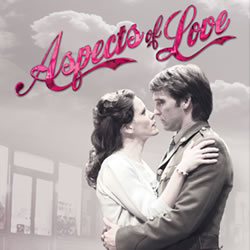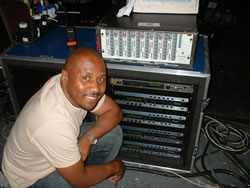
Receptor Gets Rave Reviews on Broadway...and BeyondMuse Research is taking a starring role in theater companies around the world as their Receptor dedicated hardware plug-in player is getting rave reviews! Music directors, composers and keyboard players in major Broadway, London, and touring shows have chosen Receptor as a mission-critical aspect of their shows. Let's explore how Receptor is blazing the trail into using software virtual instruments and effects in live theater both in New York and in England. Broadway, the heart of the institution that is theater in the US, has enjoyed renewed success and energy as an entirely new generation of audiences and artists have found their way to the Great White Way. Rising like a phoenix from the squalor of dilapidated theaters in the early '70s, exciting new shows such Chorus Line, Cats, Les Mis, Phantom of the Opera, Lion King, and RENT prove beyond the shadow of a doubt that the art form of music theater is just as relevant today as it was during its 'golden years' in the 40's and 50's. Indeed, as more and more technology has found its way on stage and into the pit, the experience for the theatergoer has more impact than ever, with mind-boggling special effects, studio-quality sound reinforcement, astounding musical performances, and superb scenic design… not to mention great acting, singing, and dancing. Synthesizers received a warm welcome into the world of theater with shows like Hair, Godspell, Jesus Christ Superstar, and a host of other rock musicals that debuted in the late 60's and all through the 70's. The arrival of sampling technology in the '80s, however, was perceived as more of a threat, since the initial intent of introducing such technologies was to cut down the size of the orchestra using sampled instruments instead of the real thing. As with all things new and unknown, it took a while before orchestrators, programmers, and the players themselves got their arms around this new technology. And they soon realized that when properly deployed, sampling technology can be a great enhancement to the musical experience, but in fact it is not, nor will it ever be a replacement for the "real thing"… else all musicals would be performed to background music played off a CD! David Rosenthal, Billy Joel's sideman for the last decade, has been using Receptor on tours for several years now. David uses Receptor on tour to recreate the classic and vintage sounds required by Billy's career that spans 30 years. And when Broadway showed interest in Billy's music, it was David who was tapped in the role of associate music director for " Movin Out", the Tony-winning dance extravaganza choreographed by the legendary Twyla Tharp. Currently David is involved in a new Broadway Musical called A Tale of Two Cities that is beginning its run on Broadway. David used Receptors supplement the existing instrumentation of the world premier of the show prior to its debut on Broadway, and will use four Receptors in the pit or the New York production, one for each of the two keyboard parts with one backup unit each.
David explains how he used Receptors to supplement a small orchestra and make it sound fuller by supporting the existing instrumentation: "We only had room in the pit for a violin, cello, double bass, trumpet, French horn, tympani and a woodwind doubler, basically one instrument from each section – the pit was too small to fit in any more instrumentalists. My job was to make them sound like a large orchestra by augmenting the existing instrumentation with three keyboardists. Each station had a Kurzweil 2600KS and a Receptor running the East West Platinum Pro XP library. One keyboard player focused on brass, one on strings and one on woodwinds all using Receptors. We even had the percussionist playing a KAT controller with a fourth Receptor also using the East West Library." Receptor has become the "first call synthesizer" in other shows as well, thanks to the efforts of musicians like Randy Cohen, a synth programmer and keyboardist. Randy's first experience with Receptor was when he worked with Jim Abbot, another keyboardist / programmer who worked on High Fidelity. "For High Fidelity, there was one Receptor for both the Keyboard 1 and Keyboard 2 parts. The MIDI output from both of the keyboards was merged into the one Receptor, and then the analog outs were used Keyboard 1 outputs, and then the S/PDIF out was used as the Keyboard 2 outputs. This really opened my eyes to the fact that you really can do better than just having 128MB of memory to work with!" That positive experience lead to them specifying Receptor for use with the High School Musical truck and bus tour, currently working its way around the United States: "Receptor is great for the High School Musical Tour because they just get into place, plug in their MIDI cable and they're ready to go. The Receptor has been great – the only time they had an issue was when they had a power problem at the venue but that affected everything." Randy soon found himself working on more shows, and finding more reasons to specify Receptors in various productions. His latest success is the Tony-award-winning In The Heights: "In The Heights has two keyboard players, and each keyboard player has two Receptors – one main unit and one backup. The controller is connected to a MIDI switch that allows them to switch instantly from one unit to the other should anything go wrong. They've only had to switch over to a back up unit once in one show during the entire run… so far so good. It was great programming In the Heights for the simple reason that there were no expectations about how the show should sound, and it quickly developed its own unique sound. For a long time Broadway shows reflected the music of that era, and it makes sense that we're going back into that kind of thing. I have virtual instruments all over that show – I'm using Elektrik Piano for Wurlys, I have Ivory, B4II for organ sounds… its great having a show where the technology to make sounds is used for their own sake – no controversy, just great sounds." Randy also has found Receptor's compact size and ability to be located anywhere in the pit – or even outside the pit- to be a godsend when space is at a premium, which it often is in modern productions. "I've worked with theater companies where they simply don't have the space or the budget to have vibes, marimba, xylophone, taiko drums, you name it…So they get a Mallet Kat and a Receptor and they can save themselves a lot of money and space in the pit. Also, people are getting very wise about how they use things like this. For example, they might use a Receptor for all of the large and expensive mallet instruments, but then use a real glockenspiel to get all the rich upper harmonics." And across the pond… Aspects of Love uses four Receptors to cover the new orchestration created by David Shrubsole. The score calls for violin, viola, cello and bass, plus trumpet, percussion and two keyboards. Each keyboard player is triggering two Receptors that are running Kontakt 3 using customized libraries designed specifically for the production. Many sample libraries are used to carefully supplement the existing orchestra and provide incidental sounds required by the score.
David performed programming along with his colleague Vince Hudson, who provides the following comments on Receptor: "We use four Receptors in Aspects of Love, and have a backup rig as well. We push them to the limits! After getting past a few teething problems on the show when we opened in Boston, we got the programming sorted and now thrash them to within an inch of their lives. They're incredibly reliable. I cannot see us using anything else." Back in London, David along with his colleague Mike Walker, an award wining sound designer, use 10 Receptor Pros spread across the three performance spaces at the National Theater. Four Receptors are currently in use on Nick Hytner's revival of Shaw's Major Barbara. Matthew Scott has written the music for this, with piano, keyboard, percussion, woodwind, two trumpets and tuba. Two more are in use on Fram, a new play by Tony Harrison, with music by Richard Blackford, where they are using Receptor running Absynth 4 to provide various soundscapes. So whether you are on tour with a truck and bus show, or in a theater for an extended run of the latest smash hit musical, Receptor delivers the performance, reliability, and stunning sound you need, night after night, to succeed in the world of live theater. So let the lights dim, the curtains go up, and the show begin as Receptor works its magic in orchestra pits around the world. |




 Receptor has made huge inroads in the theater scene in England as well. Mike Walker works with Loh Humm Audio, a sound design and engineering company that provides sound design and audio production and consultation services to theatre and entertainment production companies in the UK and Asia. They've found Receptor to be an invaluable tool in productions such as Andrew Lloyd Webber's Aspects of Love, currently on tour in the UK.
Receptor has made huge inroads in the theater scene in England as well. Mike Walker works with Loh Humm Audio, a sound design and engineering company that provides sound design and audio production and consultation services to theatre and entertainment production companies in the UK and Asia. They've found Receptor to be an invaluable tool in productions such as Andrew Lloyd Webber's Aspects of Love, currently on tour in the UK.


